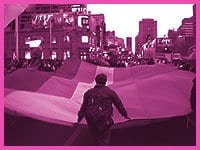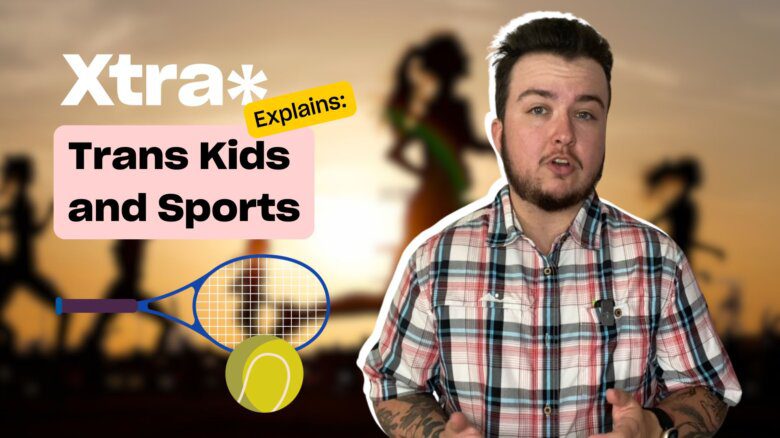Pride Toronto has been faced with a large dose of humility this year as financial troubles have gone from bad to worse, sending the volunteer-run organization begging for handouts.
But, as organizers rush to spend a wad of new government money in time to make it count, the show will go on.
With $112,000 from the provincial government, another $100,000 from Ottawa and promises of additional expenses being picked up by the city, Pride will most certainly survive its toughest year ever.
“We’re definitely relieved,” says Pride Toronto co-chair Ayse Turak. With two weeks to go, “it’s going to be a hussle, but we’re running with it.”
The money means there will be decorations on Church St, a full complement of stages and, for the first time, a marketing scheme to attract visitors and to encourage Torontonians to attend.
“In the past we haven’t marketed much because it’s Pride – people just come for Pride,” says Turak.
This year, in the wake of the war in Iraq, a declining US economy, horrible weather and of course the SARS scare, no one could be so sure.
“This has been a really hard year [even] without SARS,” says Turak.
The government money came more easily as politicians struggle to shine Toronto’s tarnished reputation after this spring’s World Health Organization travel advisory. Provincial Tourism And Recreation Minister Brian Coburn says the province is investing in Pride because it brings in visitors from all over North America and around the world.
“Pride Week is one of Toronto’s best-known festivals. As part of our tourism recovery plan, we are investing in major events that attract more visitors and help strengthen local economies,” Coburn stated when the money was announced Jun 4.
Pride Toronto, which attracts as many as 800,000 people and is considered to be one of the world’s three largest Pride celebrations, had a projected deficit of $80,000 on its $650,000 budget before the second SARS outbreak. By the time organizers went looking for salvation, the projection had ballooned to $272,000.
“The $80,000 included an anticipation of a good tourist year,” Turak said. “So that was really before SARS came along…. The fact that the number could jump from $80,000 to $272,000 shows you the kind of impact that SARS is having and will have on the event.”
Organizers have pressured the City Of Toronto to also contribute. The city is giving about $40,000 to the publication of the Official Pride Toronto Guide. In addition to the street closure permits and policing fees it usually doesn’t charge Pride for, the city has also agreed to waive a few more fees.
As well as fears that SARS will produce a smaller crowd than usual – resulting in lower revenue from beer garden sales – this has been a tough year for corporate sponsorship. The Bay, which last year contributed at the $50,000 level, pulled out back in March pre-SARS. In the past few months, other sponsors like United Airlines (which has filed for bankruptcy in the US), Captain Morgan, Crest White Strips, HP, FCUK, Schtick, Kodak and Xtra have chosen not to come back or were not able to reach a deal with Pride.
Prices for sponsorships increased, though Turak dismisses that as a factor in sponsor flight. The $5,0000 bronze sponsorship category was closed to businesses that don’t usually cater to Toronto’s gay, lesbian, bi and trans people. These businesses were asked to pay (or donate services valued at) a minimum of $15,000 in order to come on board.
Parade fees have also gone up, particularly for non-community entries. The commercial float fee is $10,000 – more than double last year’s price.
“This has had some ripple effects outside the community,” Turak says. “Some companies thought it was a strange or audacious kind of move.”
Organizers felt the parade spots were undervalued, creating a situation where companies would take the cheaper option of going in the parade instead of becoming sponsors.
“It was more to bring it in line with what it was actually worth,” says Turak, admitting they lost one or two corporate floats as a result of the hike.
Though final numbers aren’t yet available, parade entries are down slightly from last year – which is to be expected, says Turak, since last year was a banner year for participation.
Another factor has been rising insurance costs. Pride Toronto’s insurance went from $3,500 in 2001 to $65,000 last year, despite Pride never having had a single claim.
* Pride Week runs Mon, Jun 23 to Jun 29. The Dyke March is at 2pm on Sat, Jun 28; the Pride Parade is at 2pm on Sun, Jun 29. For details, check out the Ultimate Pride Guide, which is an insert in this issue of Xtra.

 Why you can trust Xtra
Why you can trust Xtra


